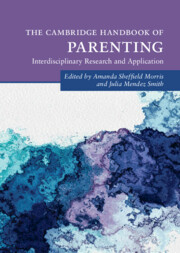Book contents
- The Cambridge Handbook of Parenting
- Cambridge Handbooks in Psychology
- The Cambridge Handbook of Parenting
- Copyright page
- Dedication
- Contents
- Contributors
- Figures
- Tables
- Introduction
- Part I Foundations of Parenting
- 1 Foundational Theories and the Establishment of Parenting Science Research
- 2 Parenting, Challenges, Brain Development, and Attachment Strategies
- 3 Parenting and Brain Development
- 4 Parenting and Children’s Social and Emotional Development: Emotion Socialization across Childhood and Adolescence
- 5 Parents Matter: The Cornerstone for Children’s Cognitive and Language Development
- 6 Discipline and Punishment in Child Development
- 7 Parenting From a Cultural and Global Perspective: A Review of Theoretical Models and Parenting Research in Diverse Cultural Contexts
- Part II Parenting across Development: Social, Emotional, and Cognitive Influences
- Part III Parental Factors That Impact Parenting
- Part IV Child Factors that Impact Parenting
- Part V Parent Education, Intervention and Policy
- Index
- References
6 - Discipline and Punishment in Child Development
from Part I - Foundations of Parenting
Published online by Cambridge University Press: 01 December 2022
- The Cambridge Handbook of Parenting
- Cambridge Handbooks in Psychology
- The Cambridge Handbook of Parenting
- Copyright page
- Dedication
- Contents
- Contributors
- Figures
- Tables
- Introduction
- Part I Foundations of Parenting
- 1 Foundational Theories and the Establishment of Parenting Science Research
- 2 Parenting, Challenges, Brain Development, and Attachment Strategies
- 3 Parenting and Brain Development
- 4 Parenting and Children’s Social and Emotional Development: Emotion Socialization across Childhood and Adolescence
- 5 Parents Matter: The Cornerstone for Children’s Cognitive and Language Development
- 6 Discipline and Punishment in Child Development
- 7 Parenting From a Cultural and Global Perspective: A Review of Theoretical Models and Parenting Research in Diverse Cultural Contexts
- Part II Parenting across Development: Social, Emotional, and Cognitive Influences
- Part III Parental Factors That Impact Parenting
- Part IV Child Factors that Impact Parenting
- Part V Parent Education, Intervention and Policy
- Index
- References
Summary
This chapter provides an overview of parents’ discipline and punishment in relation to child development. Main types of discipline (e.g., inductive reasoning, love withdrawal, power assertion) are described, and child- (e.g., behavior problems), parent- (e.g., stress), and community- (e.g., norms) level predictors of discipline are considered. The chapter then describes moderators (child gender, child age, temperament, overall climate of the parent-child relationship, and culture) and mediators (children’s perceptions of parental love and affection, social information processing, development of empathy and conscience, neurocognition) of associations between discipline and child outcomes. Next, implications of research on discipline for practice and policy are discussed in terms of the international agenda set by the Sustainable Development Goals, national bans on corporal punishment, and parenting interventions focused on discipline. The chapter concludes by examining limitations of the current research and suggesting directions for future research.
- Type
- Chapter
- Information
- The Cambridge Handbook of Parenting , pp. 120 - 143Publisher: Cambridge University PressPrint publication year: 2022



